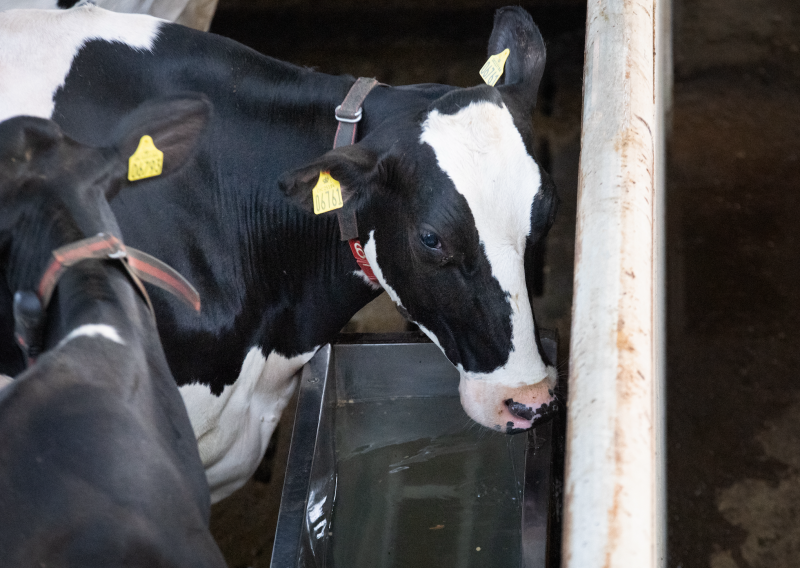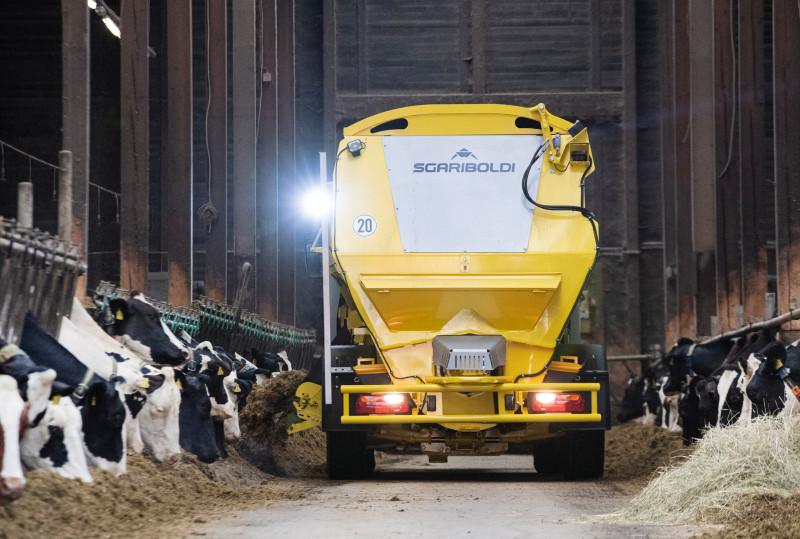
Water supply is an important element in milk production and is even more important during heat stress. That is why every farm should ensure that the cows have sufficient water availability with a high flow rate.
For several decades global warming has been a topic of discussion and analysis. In this process, the overwhelming conclusion is that in many parts of the world, the climate will show more extremes. Particularly the continually increasing temperature records and sustained periods of heat put our cows under duress. While slowing climate change is a momentous task, there are many little things we can do to protect our animals from heat stress.
JACQUES BERNARD, CHRISTINE MASSFELLER
Heat stress is a familiar concept to every dairy farmer and yet is almost always underestimated. The Temperature Humidity Index (THI) is a guideline as to when cows begin to struggle with climatic conditions. It accounts for not only temperature, but also humidity. The ideal temperature range for our cows is 4 - 16°C/40 - 60°F. Based on the THI, cows experience mild heat stress when the temperature is just 21°C/70°F and the humidity is 70%. If the humidity is only 20%, this stress is not experienced until the temperature reaches 24°C/75°F. Heat stress forces cows to expend more energy on the regulation of body temperature. Evaporation through an increase in respiration frequency, or sweating, are two common mechanisms to do this. With further increases in temperature animals reduce feed intake. At the same time cows are more restless and spend more time standing. These changes affect feeding and rumination behaviour, which primarily reduces production but decreases the animal’s health status. To shed body heat, circulation over the surface area of the body is increased and internal organs get less blood flow. Particularly for the intestines and udder, this decrease in circulation can have big consequences as there is the risk of damage to the intestinal wall or udder disease. Bacteria may enter the bloodstream and challenge the immune system, which requires even more energy. Fertility also suffers from heat stress, an effect that is often only seen later. The decrease in milk yield alone during the summer months is a large financial loss for farms, to which is added the decrease in components and increases in the amount of time spent treating animals and animal losses. As such, it is worthwhile to embrace suitable measures in a timely manner to be prepared for the coming summer. In addition to mechanical solutions in the barn that cool the cows, small changes to management and feeding can have large benefits.
FEED INTAKE
Dr. Norbert Göres, ruminant nutrition expert for the German feed company Sano – Modern Animal Nutrition, which works in countries around the world, explains the possibilities of mitigating heat stress through feeding and management. ‘It is important to holistically evaluate heat stress on your own farm. The reaction of the animals is only one aspect. Often, the effects of the hot summer months affect feeding in many barns. This starts with the open face of the silo and extends to the ration in the feed bunk, feed intake and digestion by the animal. Prophylaxis starts with producing clean, hygienic silages that are stable during storage. Just as important is tidy removal of silage with sufficient face removal (target >2m / week). This is a basic step to avoid secondary heating in the silo and to maintain stable feed intake by the cows for as long as possible. To stabilise the ration even further, effective additives can be used like, for example, Acid Protect TMR®, which contains organic acids for conservation,’ explains Göres. Keeping feed intake high is the primary objective, as under acute heat stress feed intake can decrease by up to 10%. At the same time, the cows are consuming fewer meals per day, meaning that not only do they consume less energy, protein and minerals, but that the pH value in the rumen fluctuates more, thereby increasing the risk of rumen acidosis. This enters the cow into a vicious circle as they lose more minerals through sweat. She also requires more energy for the regulation of her body temperature, which is not available to her as her feed intake has gone down.
RATION COMPOSITION
As such, Göres has several tips for optimising the ration during times of heat: ‘The effects of heat stress on feed intake must be considered during the ration formulation. With help of the ration calculations based on the CNCPS model, the expected drop in feed intake due to environmental temperature can be realistically predicted. Furthermore, the level of mineral supplementation should be increased to make up for the increased losses and to stabilise the electrolyte balance. For this, supporting rumen fermentation through the supplementation of live yeast is recommended, as well as using suitable buffering agents, like SanBuffer® for example, which increase the DCAB of the diet. Both measures help to work against rumen and metabolic acidosis.’ The ration composition is very individual, depending on the farm situation. Sufficient fibre must be always available to ensure health rumen and chewing activity. Through the warm summer months, it may be helpful, depending on the ration composition, to decrease the fibre component, as more fermentation heat is generated from fibre digestion. To offer the cow enough energy despite the decrease in feed intake, supplemental fat can be a good solution for the ration. This raises the energy density of the ration and the energy supplied through fat does not come with additional heat production during digestion.
LIMITING FACTORS
When it comes to management, it again comes down to farm specific measures. ‘As such, a robotic farm could try to make the area around the robot as attractive as possible so that cows still want to go get milked even when it’s hot, while a parlor operation should focus on a good climate in the holding pen. First off, every farm must identify its most limiting factor,’ Göres continues. This could be very different from one farm to another, and might be: barn air quality, forage quality or water availability. Therefore, it should be double checked whether an investment in ventilation or cooling technology is really the priority, or whether water availability and flow rate should be improved first. The optimisation of forage quality is always worthwhile, whether it be through the optimal cutting time point, good packing in the silo or careful covering. Feed quality remains an essential pillar of milk production. Further helpful tips for “hot phases” are multiple offerings of fresh feed throughout the day as well as moving the primary feeding time to the evening to encourage cows to eat. Additionally, other stress factors like hoof trimming or herd health checks should be reduced to the absolute minimum on warm days.
‘Every farm must identify its most limiting factor’
AIR MOVEMENT
For decades, the Dutch company Abbi-Aerotech has been working on innovations for barn ventilation and cooling. It places particular value on direct interaction with clients. ‘It is important to us that we get to know the farms of our clients as every barn is different and we need to come up with the best concept for every individual farm,’ shares Eric Bussem, the owner of Abbi-Aerotech. The systems are controlled by sensors and adjusted according to the weather conditions. There are two indicators used, the first being the previously described THI, and the second being the temperature on its own, as Bussem explains: ‘We use both parameters to be sure that the system starts early, whether it be at low temperature and high humidity or at high temperature and low humidity.’ In general, the fans start at around 15°C to lightly move air around. Through the air movement, more fresh air and with it more oxygen enters the barn from outside. That is why at low temperatures, the fans are supposed to move the air over the cows and not blow it onto them. As the temperature rises the fans are to start blowing the air onto the cows to better move away body heat. Through the various fan speeds the angle of the fans changes, and it is automatically controlled whether the air is going above the cows or onto them. That is why the fans should never be fixed in place. Depending on the barn, it must be decided whether air movement should go the length or the width of the barn. ‘We prioritise cross ventilation, whereby the air is brought in through the sidewalls. This cools the cows equally on both sides of their body because the cows are parallel to the flow of air in the eating and laying areas. Additionally, the air has a shorter distance to travel,’ explains Bussem. Nonetheless, lengthwise ventilation normally requires the same number of fans, because all areas of the barn should be equally ventilated. If this isn’t the case, there is always the risk that animals will bunch in areas of the barn where the air quality is better.
COOLING
For hot days, Abbi-Aerotech also offers cooling systems with water. ‘For these, we offer two types. One is misting, whereby water released in small drops close to the fans immediately evaporates because of the temperature and then cools the air. The second approach is the cow shower, where the animal itself is watered with large drops in order to bring down her body temperature,’ shares Bussem. For both systems, a timer controls the various wet and dry phases. Both systems have proven themselves over the years and clients are free to choose which system they would prefer.


